Chapter: 10th Mathematics : UNIT 3 : Algebra
Types of Matrices
Types of Matrices
In this section, we shall define certain types of matrices.
1. Row Matrix
A matrix is said to be a row matrix if it has only one row and any number of
columns.
A row matrix is also called as a row vector.
For example, A = (8 9 4 3), B = (-√3/2 1 √3)  are row
matrices of order 1×4 and 1×3 respectively.
are row
matrices of order 1×4 and 1×3 respectively.
In general A = (a11
a12 a13 … a1n) is a row matrix of order
1×n.
2. Column Matrix
A matrix is said to be a column matrix if it has only one column and any number of
rows. It is also called as a column vector.
For example, 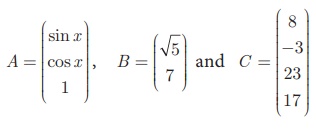 are column matrices of order 3 ×1, 2 ×1
and 4 ×1 respectively.
are column matrices of order 3 ×1, 2 ×1
and 4 ×1 respectively.
In general,  is a column matrix of order m × 1.
is a column matrix of order m × 1.
3. Square Matrix
A matrix in which the number of rows is equal to the number of columns is called a square matrix. Thus a matrix A = (aij )m ×n will be a square matrix
if m = n
For example, 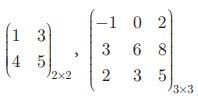 are square matrices.
are square matrices.
In general,  are square matrices of orders 2 × 2 and 3 × 3
respectively.
are square matrices of orders 2 × 2 and 3 × 3
respectively.
A = (aij )m ×m
is a square matrix of order m.
Definition : In a square matrix,
the elements of the form a11, a22, a33, . . . (i.e) aii are called leading diagonal elements. For example in the matrix  , 1 and 5 are
leading diagonal
elements.
, 1 and 5 are
leading diagonal
elements.
4. Diagonal Matrix
A square matrix, all of whose elements, except those in the
leading diagonal are zero is called a diagonal matrix.
(ie) A square matrix A = (aij ) is said
to be diagonal matrix if aij = 0 for i ≠ j
. Note that some elements of the leading diagonal may be zero but not all.
For example,  are diagonal matrices.
are diagonal matrices.
5. Scalar Matrix
A diagonal matrix in which all the leading diagonal elements are
equal is called a scalar matrix.

In general, A = (aij )m
×m is said to be a scalar matrix if

6. Identity (or) Unit Matrix
A square matrix in which elements in the leading diagonal are all
“1” and rest are all zero is called an identity matrix (or) unit matrix.
Thus, the square matrix A = (aij) is an identity matrix if aij = 
A unit matrix of order n is written as In.
 are identity matrices of order 2 and 3
respectively.
are identity matrices of order 2 and 3
respectively.
7. Zero matrix (or) null matrix
A matrix is said to be a zero matrix or null matrix if all its elements are zero.
For example,  are all zero matrices of order 1×1,
2 × 2 and 3 × 3 but of different orders.
We denote zero matrix of order n ×n by On.
are all zero matrices of order 1×1,
2 × 2 and 3 × 3 but of different orders.
We denote zero matrix of order n ×n by On.
 is a zero matrix of the order 2×3.
is a zero matrix of the order 2×3.
8. Transpose of a matrix
The matrix which is obtained by interchanging the elements in rows
and columns of the given matrix A is called transpose of A and is denoted
by AT (read as A transpose). For example,
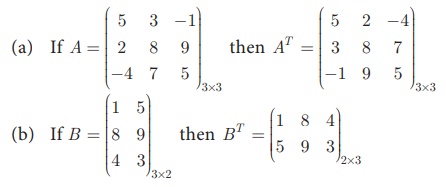
If order of A is m ×n then order of AT is n ×m .
We note that (AT )T = A.
9. Triangular Matrix
A square matrix in which all the entries above the leading
diagonal are zero is called a lower triangular matrix.
If all the entries below the leading diagonal are zero, then it is
called an upper
triangular matrix.
Definition:
A square matrix A = (aij
)n ×n is called upper triangular
matrix if aij = 0 for = 0 for i > j and is
called lower triangular matrix if aij = 0 ,
i < j .
For example, A =  is an upper triangular matrix and B =
is an upper triangular matrix and B =  is a lower triangular matrix.
is a lower triangular matrix.
Equal Matrices
Two matrices A and B are said to be equal if and
only if they have the same order and each element of matrix A is equal
to the corresponding element of
matrix B. That is, a ij =
bij for all i, j.
For example, if
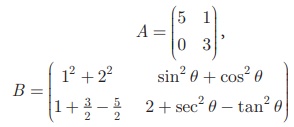
then we note that A and B have same order and aij
= bij for every i, j. Hence A and B are
equal matrices.
Progress Check
1. The number of column(s) in a column matrix are _______.
2. The number of row(s) in a row matrix are _______.
3. The non-diagonal elements in any unit matrix are______.
4. Does there exist a square matrix with 32 elements?
The negative of a matrix
The negative of a matrix Am ×n
denoted by −Am ×n is the matrix formed by
replacing each element in the matrix Am ×n
with its additive inverse.
Additive inverse of an element k is -k . That is,
every element of –A is the negative of the corresponding element of A.
For
example, if 
Example 3.53
Consider the following information regarding the number of men and women workers in three
factories I, II and III.
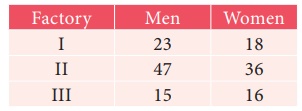
Represent the above information in the form of a matrix. What does
the entry in the second row and first column represent?
Solution
The information is represented in the form of a 3 ×2 matrix as follows

The entry in the second row and first column represent that there
are 47 men workers in factory II
Example 3.54
If a matrix has 16 elements, what are the possible orders it can have?
Solution
We know that a matrix of order m ×n , has mn elements. Thus to find all possible orders of a matrix with
16 elements, we will find all ordered pairs of natural numbers whose product is
16.
Such ordered pairs are (1,16), (16,1), (4,4), (8,2), (2,8)
Hence possible orders are 1 × 16, 16 ×1 , 4 ×4 , 2 ×8 , 8 ×2
Example 3.55
Construct a 3 ×3 matrix whose elements are a ij = i2 j 2
Solution
The general 3×3 matrix is given by
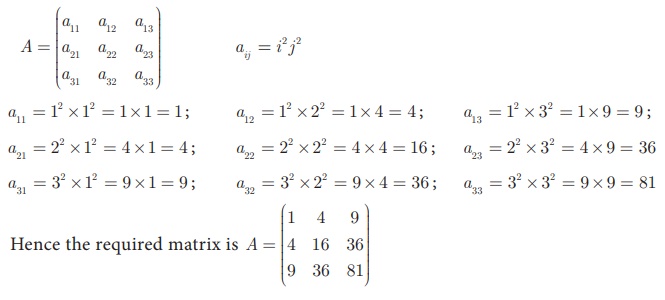
Example 3.56
Find the value of a, b, c, d
from the equation 
Solution
The given matrices are equal. Thus all corresponding elements are
equal.
Therefore,
a − b = 1…(1)
2a + c = 5…(2)
2a − b = 0…(3)
3c + d = 2…(4)
(3) Gives
2a − b = 0
2a = b …(5)
Put 2a = b in equation (1), a − 2a = 1 gives a = −1
Put a = −1 in equation (5), 2(− 1) = b gives
b = −2
Put a = −1 in equation (2), 2(− 1) +c = 5
gives c = 7
Put c = 7 in equation (4), 3(7) + d
= 2 gives d = −19
Therefore, a = −1, b = −2, c = 7, d =
−19
Related Topics